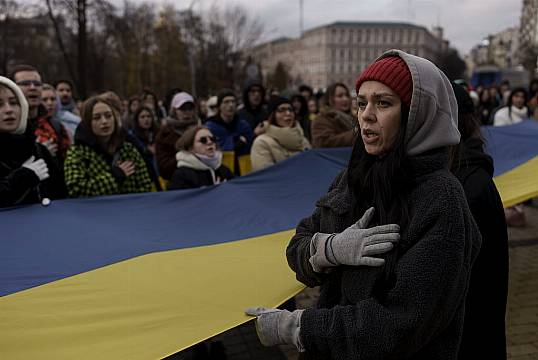US defence secretary Lloyd Austin has made an unannounced visit to Kyiv in a bid to keep money and weapons flowing to Ukraine even as US and international resources are stretched by the Israel-Hamas conflict.
Mr Austin, who travelled to Kyiv by train from Poland, met President Volodymyr Zelensky and was scheduled to meet defence minister Rustem Umerov and chief of staff Gen Valerii Zaluzhnyi.
I was honored to meet with President @ZelenskyyUa in Kyiv today to reaffirm the United States’ steadfast support for Ukraine. We, along with our allies and partners, will continue to support Ukraine’s urgent battlefield needs and long-term defense requirements. pic.twitter.com/Odv6ClgcrP
— Secretary of Defense Lloyd J. Austin III (@SecDef) November 20, 2023
In Kyiv, Mr Austin said Ukraine’s effort to defeat Russia’s invasion “matters to the rest of the world” and that US support would continue “for the long haul”.
Mr Zelensky said Mr Austin’s visit was “a very important signal for Ukraine”.
“We count on your support,“ Mr Zelensky said, thanking Congress as well as the American people for their backing.
Mr posted on X: “I’m here today to deliver an important message – the United States will continue to stand with Ukraine in their fight for freedom against Russia’s aggression, both now and into the future.”
This is Mr Austin’s second trip to Kyiv, but this visit takes place under far different circumstances.
His first visit occurred in April 2022, just two months after Russia’s large-scale invasion began.
I just arrived in Kyiv to meet with Ukrainian leaders.
I’m here today to deliver an important message – the United States will continue to stand with Ukraine in their fight for freedom against Russia’s aggression, both now and into the future. pic.twitter.com/1D96aeeACl— Secretary of Defense Lloyd J. Austin III (@SecDef) November 20, 2023
At the time, Ukraine was riding a wave of global rage at Moscow’s invasion, and Mr Austin launched an international effort that now sees 50 countries meeting monthly to coordinate on what weapons, training and other support could be pushed to Kyiv.
But the conflict in Gaza could pull attention and resources from the Ukraine fight. The US has worked since the October 7 attacks by Hamas on Israel, and the devastating bombardment on Gaza by Israel that has followed, killing more than 10,000 civilians, to prevent a wider regional war.
The US has already committed two carrier strike groups, scores of fighter jets and thousands of American personnel to the Middle East, and has had to shift its force posture and conduct air strikes against Iranian-backed militant groups who are now hitting US bases in Iraq and Syria on a regular basis.
To date, Ukraine has received more 44 billion dollars (£35 billion) from the US and more than 35 billion dollars (£28 billion) from other allies in weapons, ranging from millions of bullets to air defence systems, advanced European and US battle tanks and pledges for F-16 fighter jets.
But Ukraine still needs more, and after almost 20 months of shipping arms to Ukraine, cracks are beginning to show. Some European countries such as Poland have scaled back support, noting their need to maintain adequate fighting ability to defend themselves.
We continue to prepare for more international events next week.
The key task now is to guarantee that Ukraine maintains sufficient international support in the coming year.
I am grateful to all the counties that share our view. We must make it clear to Russia that the world… pic.twitter.com/2tOQS6KKi7— Volodymyr Zelenskyy / Володимир Зеленський (@ZelenskyyUa) November 19, 2023
Ukrainian officials have strongly pushed back on suggestions they are in a stalemate with Russia after a long-awaited counter-offensive over the summer did not radically change the battle lines on the ground.
In a visit to Washington last week, Andriy Yermak, head of the president’s office, provided no details but confirmed that Ukrainian forces had finally pushed through to the east bank of the Dnieper River, which has essentially served as the immovable front line between Ukrainian and Russian forces for months.
However, as winter sets in it will become more difficult for either side to make large gains due to ground conditions.
That could further work against Ukraine if US legislators perceive there is time to wait before more funds are needed.
A senior defence official traveling with Austin told reporters on the trip that the US expects that this winter Russia will go after Ukraine’s infrastructure again, like the power grid, making air defences critical.
Fred Kagan, a senior resident scholar at the American Enterprise Institute, said: “If we stop providing aid to Ukraine, it’s not that the stalemate continues. The aid is actually essential to preventing the Russians from beginning to manoeuvre again in ways that can allow them to defeat Ukraine.
“So the cost of cutting off aid is that Russia wins and Ukraine loses and Nato loses.”







